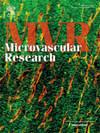冠状病毒病-2019患者的甲襞毛细血管镜成像横断面研究。
IF 2.7
4区 医学
Q2 PERIPHERAL VASCULAR DISEASE
引用次数: 0
摘要
研究目的据了解,微血管功能障碍在 SARS-CoV-2 冠状病毒病(COVID-19)的发病机制中起着关键作用。本研究的目的是评估自动定量甲襞毛细血管镜系统在识别确诊为 COVID-19 或曾患 COVID-19 的患者的微血管变化方面的实用性:本研究共招募了 97 名参与者,并将其分组如下:52名参与者患有急性COVID-19(根据疾病严重程度进一步分组),45名参与者患有恢复期COVID-19(进一步分为长期COVID,即症状超过12周且完全恢复)。使用小型 USB 手持显微镜 Dino-Lite CapillaryScope 200 Pro 获取双侧无名指的甲沟毛细血管镜图像。使用定制的自动测量软件对图像进行定量评估,并记录每位参与者的出血数量:结果:毛细血管外观主要 "正常",毛细血管环狭窄,分布均匀,但出血数量增加(康复组为 40%,急性组为 17%,P = 0.007)。毛细血管的平均宽度(20.9-21.8 μm)和血管密度(9.6-9.9 个/mm;急性组和康复组分别为 9.6-9.9 个/mm)在统计学上没有明显差异:这项研究证明了在重症监护床旁进行甲襞毛细血管镜检查的可行性。所有受 COVID-19 影响的人群的毛细血管结构均正常。虽然康复患者的微血管与急性不适患者的微血管相比存在微小差异,这可能表明 COVID-19 导致的结构延迟变化,但这些差异不太可能与临床相关。需要进行纵向研究来更详细地探讨这一问题。本文章由计算机程序翻译,如有差异,请以英文原文为准。
Imaging the microvasculature using nailfold capillaroscopy in patients with coronavirus disease-2019; A cross-sectional study
Objectives
It is understood that microvascular dysfunction plays a key role in the pathogenesis of SARS-CoV-2 coronavirus disease (COVID-19). The aim of this study was to evaluate the usefulness of an automated, quantitative nailfold capillaroscopy system in identifying microvascular changes in those confirmed with or having had COVID-19.
Methods
Ninety-seven participants were enrolled into this study and grouped as follows: 52 participants with acute COVID-19 (further grouped by disease severity) and 45 participants with convalescent COVID-19 (further grouped into long COVID i.e. symptoms beyond 12 weeks, and fully recovered). Nailfold capillaroscopy images were obtained from the bilateral ring fingers using a Dino-Lite CapillaryScope 200 Pro, a small USB handheld microscope. Images were assessed quantitatively using bespoke automated measurement software and the number of haemorrhages noted for each participant.
Results
Capillaries were predominantly ‘normal’ in appearance with narrow capillary loops and evenly distributed, but with an increased number of haemorrhages (40 % in the convalescent group and 17 % in the acute group, p = 0.007). There was no statistically significant difference in the mean width of capillaries (20.9–21.8 μm) or vessel density (9.6–9.9 caps/mm; acute and convalescent group, respectively).
Conclusions
This study has demonstrated the feasibility of nailfold capillaroscopy at the critical care bedside. Capillary structure appeared normal across all groups of individuals affected by COVID-19. Although the small differences in the microvasculature in recovered patients compared to in acutely unwell patients may suggest delayed structural change due to COVID-19, these differences are unlikely to be clinically relevant. Longitudinal studies would be required to explore this in more detail.
求助全文
通过发布文献求助,成功后即可免费获取论文全文。
去求助
来源期刊

Microvascular research
医学-外周血管病
CiteScore
6.00
自引率
3.20%
发文量
158
审稿时长
43 days
期刊介绍:
Microvascular Research is dedicated to the dissemination of fundamental information related to the microvascular field. Full-length articles presenting the results of original research and brief communications are featured.
Research Areas include:
• Angiogenesis
• Biochemistry
• Bioengineering
• Biomathematics
• Biophysics
• Cancer
• Circulatory homeostasis
• Comparative physiology
• Drug delivery
• Neuropharmacology
• Microvascular pathology
• Rheology
• Tissue Engineering.
 求助内容:
求助内容: 应助结果提醒方式:
应助结果提醒方式:


